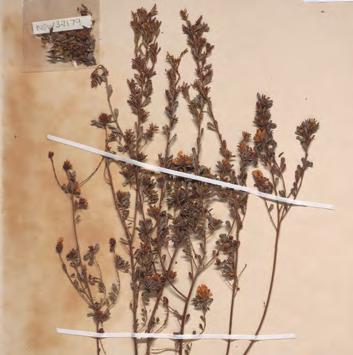
5 minute read
CREATING THE NEW SOUTH WALES PLANT Tree of Life Project
By Dr Russell Barrett and the Plant Discovery and Evolution Research team
A tree of life describes pathways of common descent and relationships amongst organisms, referred to as a ‘phylogenetic tree’ by biologists. Dr Russell Barrett explains how he and the Plant Discovery and Evolution Research team plan to create the first ever ‘tree of life’ for all native plant species in NSW using the latest genome-sequencing technology.
The New South Wales Plant Tree of Life (NSWPToL) project developed as Plant Diversity and Evolution and Collection teams prepared to move the herbarium to Mount Annan. We wanted to make best use of the facilities and resources available in the new National Herbarium of New South Wales, combining the skills and expertise of our teams. Critical factors included addressing key priorities of the NSW government as well as the needs of on-ground workers for practical outcomes from our research, matching our world-class resources and expertise with areas of greatest need.
Why create a Plant Tree of Life?
In an age of scientific scepticism, we are frequently asked about the practical benefits of our research and its relevance to everyday people. Researchers at the National Herbarium of New South Wales work at the core of biodiversity knowledge, understanding species, their origins, relationships and geographic distributions, all of which are critical to conservation efforts.
Plant classifications based on evolutionary relationships underpin our herbarium collection, valued at over $350 million, including their physical order and management. Looking at the herbarium’s history, as Australia's oldest scientific institution, we realised our collective taxonomic expertise has never covered all of the vast plant groups in our collection, and it is unlikely that it ever will. A new approach to plant systematics is needed.
New South Wales does not exist in isolation, and our chosen methodology has been proven and utilised at national and global levels. The Plant and Fungal Tree of Life project led by the Royal Botanic Gardens, Kew, recently published a paper in world's leading multidisciplinary science journal, Nature, recognising the globally significant value of DNA data. Australian herbaria made significant contributions, including 12 researchers from the National Herbarium of New South Wales (see The Gardens 142, Spring 2024 issue, pages 10-11).
Key to success are new, highly reliable genetic methods with proven results obtaining DNA from specimens up to 240 years old. We have successfully sequenced two presumed extinct species in the genus Pultenaea (peas), one specimen being 120 years old. As our herbarium has the best representation of the NSW flora anywhere in the world, our organisation is best placed to deliver this critical project.
Stage one of our NSWPToL project, for which we are currently seeking funding for three new staff and sequencing costs for five years, will sequence all native seed plants in NSW (about 7,000 species and subspecies).

While over 120 years old, this presumed extinct pea specimen still yielded high-quality genomic DNA, enabling its relationships to be critically assessed.
NSW flora anywhere in the world, our organisation is best placed to deliver this critical project.
The project will serve not only our own organisational needs for curation and research, but also workers in the fields of ecology, conservation and evolution. Combined with planned upgrades to the NSW Flora Online (PlantNET), building the NSWPToL will provide unprecedented global access to detailed knowledge of the NSW flora, informing future research in unprecedented ways.
Harvesting fragments from herbarium specimens requires a level of destructive sampling, however with only 20 milligrams of plant material needed to extract genomic DNA, impacts on precious collections are minimal. The sampling of 10,000 herbarium specimens will require extensive collaboration between our curation and research teams.
DNA sequencing technology, for the first time, provides us with a cost-effective tool for assessing our entire flora with a uniform approach. Stage one of our NSWPToL project, for which we are currently seeking funding for three new staff and sequencing costs for five years, will sequence all native seed plants in NSW (about 7,000 species and subspecies). Ultimately, we hope to sample from multiple specimens of all species to reveal genetic diversity within and between species.
Leading the way
It is clear from the 2024 International Botanical Congress in Madrid that our plans are some of the most advanced in the World. As leaders in plant phylogenomics, our efforts to create a NSWPToL will create invaluable data for researchers globally.
Evolutionary histories can explain why plants grow where they do, and how they breed. Mapping the shared DNA of NSW plant species will help us understand which plant lineages survived and thrived during our geological past, and which were forced into refugia during climatic shifts, greatly enhancing our ability to focus our conservation resources.
We will add value to collections already enhanced through photographic digitisation, which captured high resolution images of each herbarium specimen. We will now be unlocking their very DNA – the invaluable information hidden within their cells.
The NSWPToL therefore represents a fundamental unit of knowledge and digital infrastructure that our current and future researchers need. We are seeking funding now, as our new herbarium is settled, digitisation is complete, and advanced genomic methods are proven. We believe the NSWPToL will be a cost-effective investment in the future of our state’s precious biodiversity that will pay for itself many times over.










